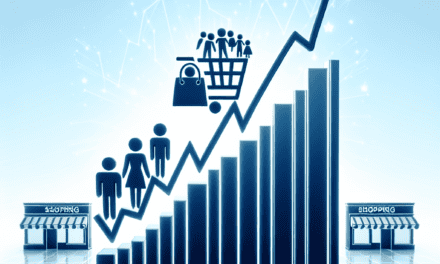“Seize the Surge: Navigating the FOMO Market’s Comeback”
Introduction
“The Return of the FOMO Market: Morning Brief” delves into the resurgence of the Fear of Missing Out (FOMO) phenomenon in financial markets. As investors grapple with volatile economic conditions and rapidly shifting market dynamics, the allure of high-risk, high-reward opportunities has intensified. This briefing explores the factors driving the renewed FOMO sentiment, examining its impact on investment strategies and market behavior. By analyzing current trends and investor psychology, it provides insights into how FOMO is reshaping the landscape, influencing decision-making, and potentially setting the stage for both opportunities and pitfalls in the financial world.
Understanding The FOMO Market: A Brief Overview
In recent years, the financial markets have witnessed a resurgence of the phenomenon known as the “Fear of Missing Out,” or FOMO. This psychological trigger, which compels investors to make hasty decisions driven by the anxiety of missing potential gains, has become increasingly prevalent. Understanding the dynamics of the FOMO market is crucial for investors seeking to navigate the complexities of modern financial landscapes.
The FOMO market is characterized by rapid price movements and heightened volatility, often fueled by speculative trading and media hype. As investors observe others reaping substantial profits, the fear of being left behind can lead to impulsive buying decisions. This behavior is not new; however, the advent of social media and digital communication platforms has amplified its impact. Information spreads at an unprecedented pace, creating a feedback loop where market sentiment can shift dramatically within hours.
One of the primary drivers of the FOMO market is the accessibility of trading platforms. With the rise of commission-free trading apps, a new generation of retail investors has entered the market. These platforms have democratized access to financial markets, allowing individuals to trade with ease. While this democratization is a positive development, it also means that inexperienced investors are more susceptible to FOMO-driven decisions. The allure of quick profits can overshadow the importance of thorough research and risk management.
Moreover, the FOMO market is often fueled by narratives that capture the public’s imagination. Whether it’s the promise of revolutionary technology, such as blockchain and cryptocurrencies, or the potential of disruptive business models, these stories can create a sense of urgency. Investors, eager to capitalize on the next big thing, may overlook fundamental analysis in favor of speculative bets. This behavior can lead to asset bubbles, where prices are driven far beyond their intrinsic value.
Transitioning to the role of institutional investors, it is important to note that they are not immune to the effects of FOMO. While they possess more resources and expertise, they too can be swayed by market sentiment. The pressure to deliver returns can lead to herd behavior, where institutions follow trends rather than setting them. This can exacerbate market volatility, as large volumes of capital move in and out of assets based on perceived momentum.
In light of these dynamics, it is essential for investors to adopt a disciplined approach. Developing a well-defined investment strategy, grounded in fundamental analysis and long-term goals, can help mitigate the influence of FOMO. Diversification, too, plays a critical role in managing risk. By spreading investments across different asset classes and sectors, investors can reduce their exposure to the volatility inherent in FOMO-driven markets.
Furthermore, staying informed is paramount. While the rapid dissemination of information can contribute to FOMO, it can also be a valuable tool for making informed decisions. Investors should seek out reliable sources of information and remain skeptical of sensationalist headlines. By maintaining a balanced perspective, they can better assess the true potential of investment opportunities.
In conclusion, the return of the FOMO market underscores the importance of understanding the psychological factors that drive investor behavior. While the allure of quick profits can be tempting, a disciplined and informed approach is essential for navigating the complexities of modern financial markets. By recognizing the signs of FOMO and adhering to sound investment principles, investors can position themselves for long-term success amidst the ever-changing market landscape.
Key Drivers Behind The Return Of The FOMO Market
In recent months, the financial markets have witnessed a resurgence of the Fear of Missing Out, commonly referred to as FOMO, a phenomenon that has historically driven investors to make impulsive decisions based on the fear of missing lucrative opportunities. This renewed vigor in the FOMO market can be attributed to several key drivers that have collectively influenced investor behavior and market dynamics. Understanding these drivers is crucial for both seasoned investors and newcomers seeking to navigate the complexities of the current financial landscape.
To begin with, the global economic recovery from the pandemic-induced downturn has played a significant role in reigniting investor enthusiasm. As economies worldwide have gradually reopened, there has been a notable uptick in consumer spending, business investments, and overall economic activity. This resurgence has been further bolstered by government stimulus measures and accommodative monetary policies, which have injected liquidity into the markets. Consequently, investors have been eager to capitalize on the anticipated growth, leading to a surge in market participation and a heightened sense of urgency to invest before prices climb even higher.
Moreover, technological advancements and the proliferation of digital platforms have democratized access to financial markets, enabling a broader demographic of investors to participate. The rise of commission-free trading apps and the increasing popularity of cryptocurrencies have particularly attracted younger, tech-savvy individuals who are more inclined to engage in speculative trading. This influx of new participants has contributed to the FOMO-driven market environment, as these investors often rely on social media and online forums for investment advice, where hype and momentum can quickly amplify.
In addition to these factors, the low-interest-rate environment has compelled investors to seek higher returns in riskier assets. With traditional savings accounts and fixed-income investments offering meager yields, individuals and institutions alike have been driven to explore equities, real estate, and alternative investments in search of better returns. This shift in investment strategy has further fueled the FOMO market, as investors are keen to identify and seize opportunities that promise substantial gains.
Furthermore, the psychological aspect of FOMO cannot be overlooked. Human behavior is inherently influenced by emotions, and the fear of missing out on potential profits can lead to irrational decision-making. In a market characterized by rapid price movements and sensational headlines, investors may feel pressured to act swiftly, often disregarding fundamental analysis and long-term strategies. This behavior is exacerbated by the constant barrage of information and the ease with which news spreads in the digital age, creating an environment where market sentiment can shift rapidly and unpredictably.
While the return of the FOMO market presents opportunities for significant gains, it also carries inherent risks. Investors must remain vigilant and exercise caution, as the volatility associated with FOMO-driven markets can lead to substantial losses. It is essential for investors to conduct thorough research, diversify their portfolios, and maintain a disciplined approach to mitigate the potential downsides.
In conclusion, the resurgence of the FOMO market is driven by a confluence of economic recovery, technological advancements, low-interest rates, and psychological factors. As investors navigate this dynamic environment, understanding these key drivers can provide valuable insights into market behavior and help inform sound investment decisions. By balancing the desire for immediate gains with prudent risk management, investors can better position themselves to capitalize on opportunities while safeguarding their financial well-being.
How Investors Can Navigate The FOMO Market
In recent months, the financial markets have witnessed a resurgence of the so-called “FOMO” phenomenon, an acronym for the “Fear of Missing Out.” This psychological trigger, which compels investors to jump into rapidly rising markets to avoid missing potential gains, has once again become a significant driving force. As the global economy shows signs of recovery and technological advancements continue to reshape industries, investors are increasingly eager to capitalize on emerging opportunities. However, navigating a FOMO-driven market requires a strategic approach to mitigate risks while maximizing potential returns.
To begin with, it is essential for investors to maintain a disciplined investment strategy. While the allure of quick profits can be tempting, it is crucial to adhere to a well-defined plan that aligns with one’s financial goals and risk tolerance. This involves conducting thorough research and due diligence before making investment decisions. By understanding the fundamentals of the assets in question, investors can make informed choices rather than succumbing to impulsive actions driven by market hype.
Moreover, diversification remains a key principle in managing risk within a FOMO market. By spreading investments across various asset classes, sectors, and geographic regions, investors can reduce the impact of volatility on their portfolios. This approach not only helps in safeguarding against potential losses but also provides exposure to a broader range of growth opportunities. In this context, exchange-traded funds (ETFs) and mutual funds can serve as effective tools for achieving diversification, offering access to a basket of securities with a single investment.
In addition to diversification, maintaining a long-term perspective is vital. While FOMO markets are often characterized by short-term price surges, it is important to focus on the underlying value and growth potential of investments. By adopting a patient approach, investors can avoid the pitfalls of chasing fleeting trends and instead benefit from the compounding effects of sustained growth over time. This long-term mindset also helps in weathering market corrections, which are inevitable in any investment landscape.
Furthermore, staying informed about market trends and developments is crucial for navigating a FOMO market. This involves keeping abreast of economic indicators, corporate earnings reports, and geopolitical events that may influence market dynamics. By staying informed, investors can better anticipate potential shifts in market sentiment and adjust their strategies accordingly. Additionally, leveraging insights from financial analysts and industry experts can provide valuable perspectives and enhance decision-making processes.
Another important consideration is the role of technology in today’s FOMO market. With the rise of digital platforms and social media, information spreads rapidly, often amplifying market movements. While these tools can provide valuable insights, they can also contribute to heightened volatility and emotional decision-making. Therefore, it is essential for investors to critically evaluate the sources of information and avoid being swayed by sensational headlines or unverified claims.
In conclusion, while the return of the FOMO market presents exciting opportunities, it also demands a cautious and strategic approach. By adhering to a disciplined investment strategy, diversifying portfolios, maintaining a long-term perspective, staying informed, and critically evaluating information sources, investors can navigate the complexities of a FOMO-driven market. Ultimately, the key lies in balancing the desire for potential gains with prudent risk management, ensuring that investment decisions are guided by rational analysis rather than emotional impulses.
The Role Of Social Media In The FOMO Market Resurgence
In recent years, the financial landscape has witnessed a resurgence of the FOMO (Fear of Missing Out) market, a phenomenon largely driven by the pervasive influence of social media. This resurgence is characterized by a heightened sense of urgency among investors, who are eager to capitalize on rapidly evolving market trends. Social media platforms have become instrumental in shaping investor behavior, serving as both a catalyst and a conduit for the dissemination of information. As a result, understanding the role of social media in this context is crucial for comprehending the dynamics of the modern FOMO market.
To begin with, social media platforms such as Twitter, Reddit, and Instagram have democratized access to financial information, enabling a broader audience to engage with market trends. This democratization has led to the proliferation of investment communities where individuals share insights, strategies, and predictions. Consequently, these platforms have become breeding grounds for viral investment ideas, often leading to rapid market movements. For instance, the GameStop saga in early 2021 exemplified how social media can amplify market trends, as retail investors rallied together on platforms like Reddit to drive up the stock’s price. This event underscored the power of collective action facilitated by social media, highlighting its role in the FOMO market resurgence.
Moreover, social media has accelerated the speed at which information spreads, contributing to the volatility characteristic of FOMO markets. In the past, investors relied on traditional media outlets and financial reports to make informed decisions. However, the immediacy of social media allows for real-time updates and discussions, enabling investors to react swiftly to market developments. This rapid dissemination of information can lead to impulsive decision-making, as investors fear being left behind in potentially lucrative opportunities. Consequently, the FOMO market is often marked by short-lived trends and heightened volatility, driven by the constant influx of information on social media.
In addition to facilitating information exchange, social media has also given rise to influential personalities who wield significant sway over market sentiment. These individuals, often referred to as “finfluencers,” leverage their large followings to promote specific stocks or investment strategies. Their endorsements can lead to substantial market movements, as followers rush to emulate their actions. This phenomenon further fuels the FOMO market, as investors seek to align themselves with perceived experts in the field. However, it also raises concerns about the potential for misinformation and market manipulation, as not all finfluencers possess the requisite expertise or ethical standards.
Furthermore, the visual and interactive nature of social media platforms enhances their appeal, particularly among younger investors. The use of engaging content, such as memes and videos, makes financial information more accessible and relatable. This approach resonates with a generation accustomed to consuming information in bite-sized, visually appealing formats. As a result, social media has played a pivotal role in attracting a new wave of investors to the market, many of whom are driven by the fear of missing out on the next big opportunity.
In conclusion, the resurgence of the FOMO market can be attributed in large part to the influence of social media. By democratizing access to information, accelerating its dissemination, and fostering influential personalities, social media has reshaped the way investors engage with the market. While this has led to increased participation and dynamism, it has also introduced new challenges, such as heightened volatility and the risk of misinformation. As the financial landscape continues to evolve, understanding the role of social media in the FOMO market will be essential for navigating its complexities and capitalizing on its opportunities.
Comparing Past And Present FOMO Market Trends
The concept of FOMO, or the “Fear of Missing Out,” has long been a driving force in financial markets, influencing investor behavior and market dynamics. Historically, FOMO has been characterized by a rapid influx of investment driven by the fear of missing out on potential gains, often leading to inflated asset prices and increased market volatility. As we examine the resurgence of the FOMO market in recent times, it is essential to compare past and present trends to understand the underlying factors and potential implications for investors.
In the past, FOMO markets were often fueled by speculative bubbles, where exuberant investor sentiment overshadowed fundamental valuations. The dot-com bubble of the late 1990s serves as a quintessential example, where the allure of internet-based companies led to skyrocketing stock prices, only to culminate in a dramatic market correction. Similarly, the housing market bubble of the mid-2000s was driven by a combination of easy credit and speculative buying, resulting in a financial crisis that had far-reaching consequences.
Transitioning to the present, the resurgence of FOMO can be attributed to several factors, including technological advancements, social media influence, and the democratization of trading platforms. The rise of social media has amplified the spread of information, allowing market trends to gain momentum at an unprecedented pace. Platforms like Twitter and Reddit have become breeding grounds for investment discussions, where viral posts can lead to sudden surges in stock prices, as seen in the GameStop saga of early 2021. This phenomenon highlights the power of collective investor action, where the fear of missing out on a trending stock can drive significant market movements.
Moreover, the democratization of trading through platforms like Robinhood has lowered the barriers to entry for retail investors, enabling a new generation of market participants to engage in trading activities. This shift has contributed to the current FOMO market, as retail investors, armed with easy access to trading tools and information, are more inclined to chase high-flying stocks and cryptocurrencies. The accessibility of these platforms has also led to increased market liquidity, further fueling the FOMO-driven investment landscape.
Despite these differences, there are notable similarities between past and present FOMO markets. Both are characterized by heightened volatility and the potential for significant market corrections. The rapid rise in asset prices, often detached from underlying fundamentals, poses a risk of sudden reversals, as seen in previous market bubbles. Additionally, the psychological aspect of FOMO remains a constant, as investors grapple with the fear of being left behind in a rapidly evolving market environment.
In conclusion, while the drivers of the current FOMO market differ from those of the past, the underlying dynamics remain similar. The interplay of technological advancements, social media influence, and the democratization of trading has created a unique landscape where FOMO continues to shape investor behavior. As we navigate this environment, it is crucial for investors to remain vigilant, balancing the allure of potential gains with the inherent risks of a FOMO-driven market. By understanding the lessons of the past and recognizing the nuances of the present, investors can make informed decisions that align with their long-term financial goals.
Potential Risks And Rewards In The FOMO Market
In recent years, the financial landscape has been characterized by a phenomenon known as the “Fear of Missing Out” (FOMO) market, where investors, driven by the anxiety of missing lucrative opportunities, rush to invest in trending assets. This behavior, while potentially rewarding, carries inherent risks that must be carefully considered. As the FOMO market makes its return, understanding the dynamics at play is crucial for both seasoned investors and newcomers alike.
The resurgence of the FOMO market can be attributed to several factors, including the rapid dissemination of information through social media platforms and the increasing accessibility of trading tools. These developments have democratized investing, allowing a broader audience to participate in financial markets. However, this democratization also means that market sentiment can shift rapidly, often driven by viral trends rather than fundamental analysis. Consequently, investors may find themselves caught in a cycle of buying high and selling low, as they react to the latest buzz rather than relying on sound investment strategies.
Moreover, the FOMO market is often characterized by heightened volatility. As investors flock to popular assets, prices can soar to unsustainable levels, only to plummet when the initial excitement wanes. This volatility can be particularly challenging for those who are unprepared or lack a long-term investment plan. While some may benefit from short-term gains, others may suffer significant losses, underscoring the importance of risk management and diversification in investment portfolios.
Despite these risks, the FOMO market also presents unique opportunities for those who approach it with caution and a well-thought-out strategy. For instance, investors who conduct thorough research and maintain a disciplined approach can capitalize on emerging trends before they become mainstream. By identifying undervalued assets with strong growth potential, these investors can achieve substantial returns while minimizing exposure to market fluctuations.
Furthermore, the FOMO market can serve as a catalyst for innovation and growth within various sectors. As capital flows into trending industries, companies are incentivized to develop new technologies and expand their offerings, ultimately benefiting consumers and the economy as a whole. This influx of investment can lead to breakthroughs in fields such as renewable energy, biotechnology, and digital finance, driving progress and creating new opportunities for investors.
To navigate the complexities of the FOMO market, it is essential for investors to remain informed and adaptable. Staying abreast of market trends and developments can provide valuable insights into potential investment opportunities. Additionally, maintaining a diversified portfolio can help mitigate risks associated with market volatility, ensuring that investors are not overly reliant on any single asset or sector.
In conclusion, the return of the FOMO market presents both risks and rewards for investors. While the allure of quick profits can be tempting, it is crucial to approach this market with a clear understanding of its dynamics and potential pitfalls. By adopting a disciplined investment strategy and remaining vigilant in the face of market fluctuations, investors can position themselves to capitalize on the opportunities presented by the FOMO market while safeguarding their financial well-being. As the financial landscape continues to evolve, the ability to balance risk and reward will remain a key determinant of success in the ever-changing world of investing.
Expert Predictions On The Future Of The FOMO Market
The resurgence of the FOMO (Fear of Missing Out) market has captured the attention of investors and analysts alike, prompting a wave of expert predictions about its future trajectory. As market dynamics evolve, understanding the factors driving this phenomenon becomes crucial for stakeholders aiming to navigate the complexities of modern investment landscapes. The FOMO market, characterized by rapid price increases driven by investor enthusiasm and a fear of missing out on potential gains, has re-emerged in recent months, fueled by a confluence of economic, technological, and social factors.
To begin with, the economic backdrop plays a significant role in the revival of the FOMO market. Low interest rates and expansive monetary policies have created an environment where traditional savings yield minimal returns, pushing investors towards riskier assets in search of higher yields. This shift in investment strategy has been further amplified by the gradual recovery from the global pandemic, which has instilled a sense of optimism and a willingness to embrace risk among investors. Consequently, the influx of capital into equities, cryptocurrencies, and other speculative assets has reignited the FOMO sentiment, as individuals seek to capitalize on perceived opportunities before they dissipate.
Moreover, technological advancements have significantly contributed to the resurgence of the FOMO market. The proliferation of digital platforms and mobile applications has democratized access to financial markets, enabling a broader demographic to participate in trading activities. This increased accessibility has not only expanded the investor base but also accelerated the dissemination of market information, leading to heightened volatility and rapid price movements. Social media platforms, in particular, have emerged as powerful catalysts for FOMO-driven behavior, as they facilitate the rapid spread of investment trends and narratives, often amplifying the fear of missing out among retail investors.
In addition to economic and technological factors, social dynamics have also played a pivotal role in shaping the current FOMO market. The rise of online communities and forums dedicated to investment discussions has fostered a sense of collective enthusiasm and urgency. These communities often serve as echo chambers, where bullish sentiments are reinforced, and dissenting opinions are marginalized. As a result, investors may feel compelled to act swiftly to align with the prevailing sentiment, further fueling the FOMO cycle. This phenomenon is particularly evident in the cryptocurrency market, where social media-driven hype can lead to dramatic price surges and subsequent corrections.
Looking ahead, experts offer varied predictions on the future of the FOMO market. Some analysts caution that the current exuberance may be unsustainable, warning of potential market corrections as valuations become increasingly detached from underlying fundamentals. They argue that the FOMO-driven rallies could lead to asset bubbles, which, if left unchecked, may result in significant financial instability. On the other hand, optimists contend that the FOMO market could persist, driven by continued technological innovation and evolving investor behavior. They suggest that as long as economic conditions remain favorable and technological advancements continue to reshape market dynamics, the FOMO sentiment may endure, albeit with periodic fluctuations.
In conclusion, the return of the FOMO market underscores the intricate interplay between economic conditions, technological advancements, and social dynamics. As investors navigate this complex landscape, understanding the underlying drivers of FOMO behavior becomes essential for making informed decisions. While expert predictions on the future of the FOMO market vary, one thing remains clear: the phenomenon is a testament to the evolving nature of modern financial markets, where fear and opportunity coexist in a delicate balance.
Q&A
1. **What is the FOMO market?**
The FOMO (Fear of Missing Out) market refers to a market environment where investors are driven by the fear of missing out on potential gains, leading to increased buying activity and often resulting in inflated asset prices.
2. **What factors contribute to the return of the FOMO market?**
Factors contributing to the return of the FOMO market include positive economic indicators, low interest rates, increased retail investor participation, and media hype around certain stocks or sectors.
3. **How does investor behavior change in a FOMO market?**
In a FOMO market, investors tend to exhibit herd behavior, making impulsive investment decisions based on emotions rather than fundamentals, often chasing high-performing stocks or sectors.
4. **What are the risks associated with a FOMO market?**
Risks include overvaluation of assets, increased market volatility, potential for significant losses when the market corrects, and the possibility of a bubble forming and bursting.
5. **How can investors protect themselves in a FOMO market?**
Investors can protect themselves by maintaining a diversified portfolio, focusing on long-term investment strategies, conducting thorough research, and avoiding impulsive decisions based on market hype.
6. **What role do social media and online platforms play in a FOMO market?**
Social media and online platforms amplify FOMO by rapidly spreading information, rumors, and hype, influencing investor sentiment and behavior, and often leading to increased market volatility.
7. **What historical examples illustrate the impact of a FOMO market?**
Historical examples include the dot-com bubble of the late 1990s, the housing bubble leading up to the 2008 financial crisis, and the GameStop short squeeze in early 2021, all characterized by rapid price increases driven by FOMO.
Conclusion
“The Return of the FOMO Market: Morning Brief” likely discusses the resurgence of the “Fear of Missing Out” (FOMO) sentiment among investors, driven by market dynamics such as rising asset prices, increased retail participation, or speculative trading. This environment can lead to heightened volatility and risk-taking as investors rush to capitalize on perceived opportunities. The conclusion might emphasize the importance of cautious optimism, suggesting that while FOMO can drive short-term gains, it also necessitates careful risk management and a focus on long-term investment strategies to avoid potential pitfalls associated with speculative bubbles.





